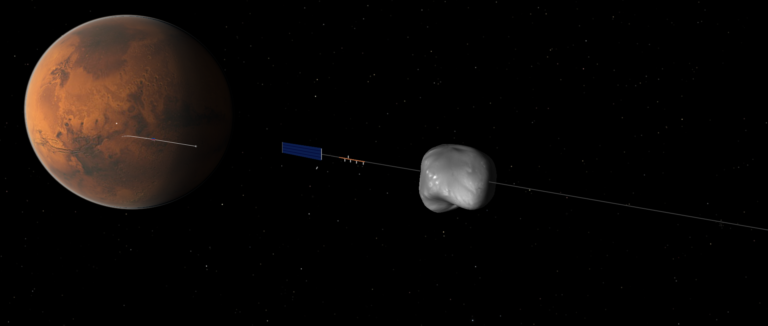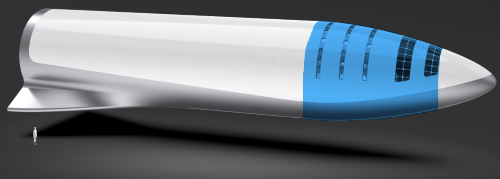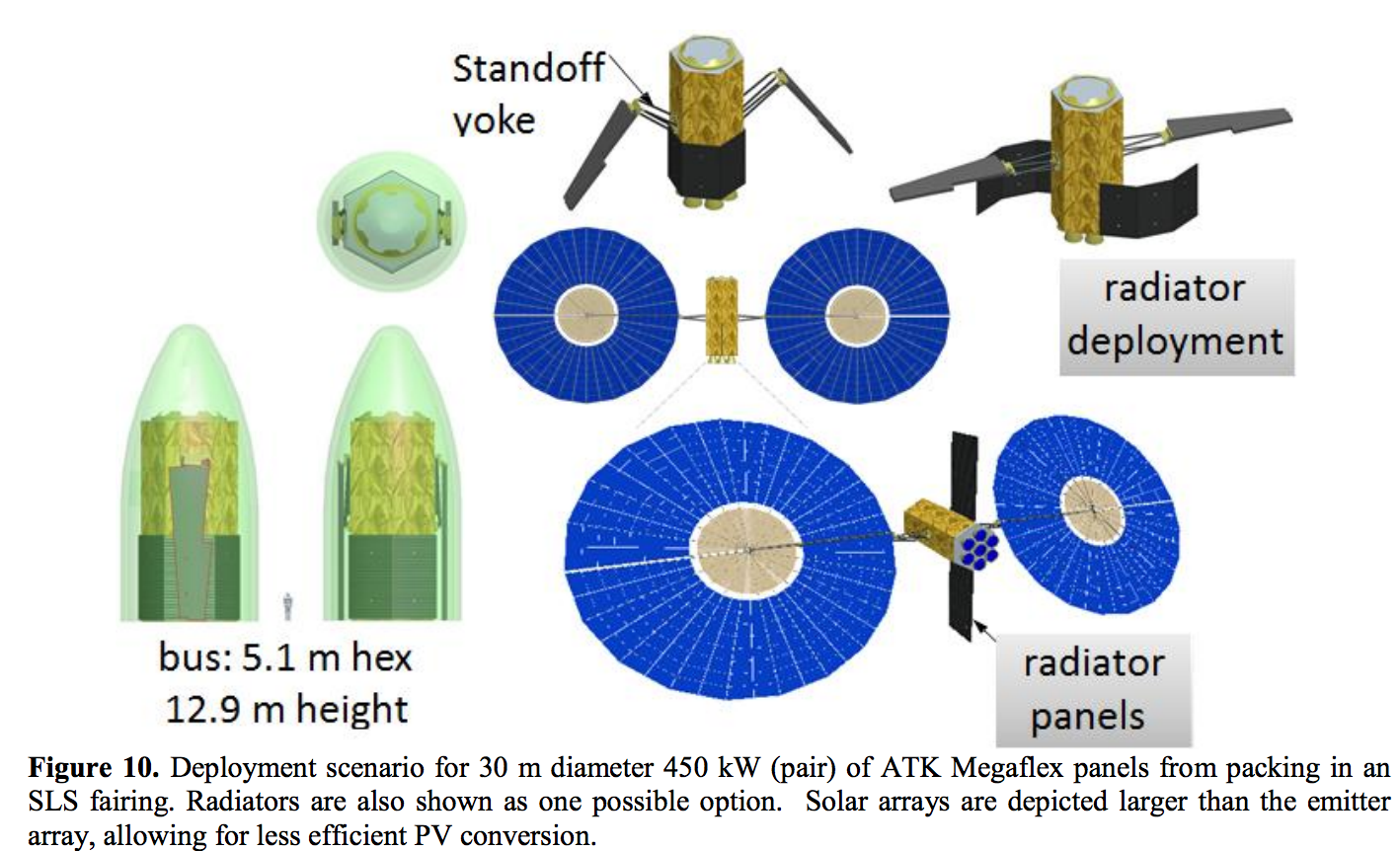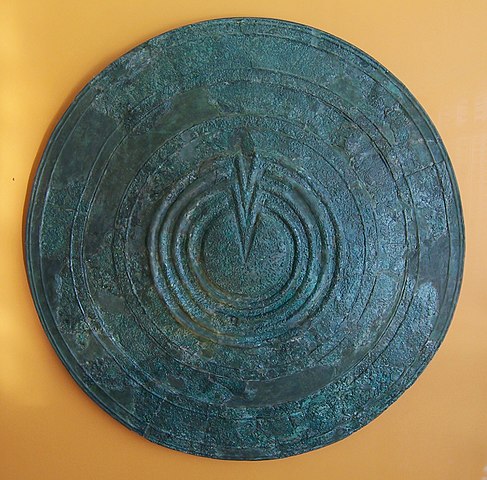New Mars Forums
You are not logged in.
- Topics: Active | Unanswered
Announcement
#26 Re: Exploration to Settlement Creation » Radiation amount type risk mitigation » 2017-11-28 10:09:42
The .66-ish sieverts in space and .2 to .3 sieverts on Mars is GCR exposure. That's the steady drizzle. The occasional solar flare is many orders of magnitude higher, very directional, and rather short duration (hours to a day or so).
I don't speak "sieverts, I speak REM, which I think differ by a factor of 100. At Earth's distance from the sun, GCR varies from 24 to 60 REM per year, more-or-less sinusoidally, with an approximate 11 year period matching the sunspot cycle. Lots of sunspot activity reduces the GCR flux, and vice versa. Probably a variable solar wind effect.
NASA's own astronaut exposure rules (off their radiation website) are 50 REM max in any one year, 25 REM max in any one month, and a career limit that varies with age and gender, but peaks at 400 REM total over the career. Supposedly these rules were developed to limit late in life cancer risks to 3% above normal. That actually compares quite well with the 5.5% increased risk associated with .6 sievert (60 REM) I see quoted above.
I don't see much of a problem for exploration crews, who generally will be willing to take the 3-6% increased risk, fuzzy as those criteria really (and fundamentally) are. Long-term base crews will get limited by the career limit to rather short stays, I think. Not very many years, for sure.
The real problem is colonists, especially children. Those exposures at 3-6% increased risk are around factor 10 too high for long-term exposures, and factor 100 too high for children. That means significant regolith cover is required long-term, and not just for solar flare protection.
A solar flare recently smacked Mars dead nuts on, and lit up an aurora all over the planet. I don't recall seeing doses reported, although I'd bet Curiosity measured them. Really big flares can be 10,000+ REM per hour! The Martian atmosphere only reduces that exposure by a factor of 2 to 3, if the GCR reduction is any guide. Solar flare stuff is easier to shield than GCR, so thick regolith cover should work for that, especially if it has a little ice in it.
The problem with too-thick is secondary scatter radiation. I have no figures for what is too thick, though.
The NASA radiation website is where I got the 15-20 cm of water figure that would protect adequately from a solar flare, and reduces the GCR a little bit, without any secondary shower effects. Their curves indicated effectiveness out to double those figures.
It would appear to me that what Curiosity uncovered during its trip to Mars and since while on Mars is pretty consistent with the effects and the exposure rules posted years ago on the NASA radiation website. This stuff really isn't news, just confirmation. But some seem to be misusing it as a scare tactic not to go.
All that being said, then where is the radiation shelter in the Gateway design? Not the GCR, that's an accepted risk and a stay limiter. I mean the 10,000+ REM/hour shelter! Like a surface nuclear explosion's fallout, that is. 500 REM accumulated in a short interval like minutes, hours, or even a few days is the "fatal dose" figure. They'll kill a crew without one.
GW
Good (data) points to keep in mind, surely. Maybe you'd have some thoughts on improvements to a water shield:
SpaceX spaceship, Omaha Trail water shielding in blue.
To set a target for in-transit protection on the Omaha Shield's Omaha Trail, we aimed for an additional 90% reduction in flare proton flux. To reach that target, we added 130 t of Deimos ISRU water, distributed around the quarters of a 2017 SpaceX ITS spaceship. That gives 1 m+ water shielding. This is far more than the 15-20 cm shielding you cited, but it seems necessary for 90% reduction because water is a poor shield against energetic protons when the shield thickness is under 20 cm.
But of course that's a lot of water, and flight efficiencies improve if shield mass can be reduced. Glad for any thoughts on that.
One thought: Adding a thin high-Z layer
A thin layer of high-Z material could be integrated into the water shield, either serving as the vessel's inner surface or else standing within the water volume. Pound-for-pound, water is hard to beat as a flight-safe proton shield. However two-layer or graded-Z shielding can improve performance in some cases, as in Atwell et al. 2013 Fig. 3. But even there, the inferred benefit to a thick water shield is negligible, as seen in Fig. 5.
Long story short: it's not obvious that any thin high-Z shielding layer will offer a big cut in the proposed water mass.
#27 Re: Human missions » Omaha Shield: radiation protection systems for Unlimited Mars Career » 2017-11-27 22:27:02
Could you explain "proposed tether-rail launcher at Deimos"? It sounds like it wouldn't be on the surface of the moon, but above it, presumably so it can be pointed in the right direction for launching things toward Earth. That sounds like a great way to reduce transit costs.
Hi. Yes, the aim is to improve transit, by cutting propellant, transit time, cosmic ray exposure, etc.
DRL cabling extends from Deimos through L2, for mass-efficiency and tensioning.
Delta-V 1 km/s inbound, for optimal Mars periapsis gravity-assist.
Some DRL slides in:
- BIS Omaha Trail presentation Nov 2017.
#28 Re: Human missions » Omaha Shield: radiation protection systems for Unlimited Mars Career » 2017-11-27 20:12:47
Why do we need to dig 9km holes on Mars?
Simply put, to cut the cost and difficulty of Mars facilities very significantly. Radiation protection, giant habs, continual power, food self-sufficiency, ISRU facilities, precious metal mining -- all are much easier with Omaha Crater resources.
Escaping the scaling law of pressure vessels, with large subaqueous habs, is by itself a strong justification. Imagine the cost reduction, when one cargo can build a hab of 2 million cubic meters, as compared to today's limit of a few thousand cubic meters.
Game-changer. That's why we did the work.
I've never seen or heard of an asteroid being redirected using a laser.
Do check out that linked reference paper, up above. NASA / UCSB have done a lot of work to realize the DE-STARLITE tech, specifically for deflection of small bodies. It's just sitting there, waiting.
The rubber needs to meet the road somewhere in order for this colonization idea to gain traction.
Surely. It will really meet the road if a leader commits his team to ramming the terraformer into Mars.
Where could we hope to find a bigger game-changer than that?
#29 Re: Human missions » Omaha Shield: radiation protection systems for Unlimited Mars Career » 2017-11-27 13:45:46
After we acquire the technology for space elevators and lasers that can move asteroids onto a collision course with Mars, we can probably still dig holes in the ground for less money. Humans have been digging holes for a long time.
Warm 9 km holes aren't so easy to dig on Mars.
And the laser system for small-body deflection already exists of course. We give it a job.
#30 Re: Human missions » Omaha Shield: radiation protection systems for Unlimited Mars Career » 2017-11-27 11:01:37
If you want water for a colony, then locate some ice in the Martian regolith. It's a lot easier than shipping it to Mars from Deimos.
The selected site for Omaha Crater is rich in ice; hence the selection. MATT impact provides immense heat energy, which is very useful. There's nothing especially impractical about that. Invention details aim for practical execution.
Note that Deimos water would not be shipped to Mars. That water would serve on the Omaha Trail primarily as shielding material, for ships in transit. They'd dump the shield before EDL, as the water isn't needed after transit.
Also, have you taken a look at Dr. Lades' work on the Mars Lift design? It's the first design that's actually shown to avoid Phobos, passively, and while using plausible CNT material. Also our unpowered "rappeller" concept aims to further simplify elevator operation, relative to powered designs.
#31 Re: Terraformation » Magnetizing Mars - Creation of a Martian Magnetosphere » 2017-11-27 10:49:38
That's brilliant!
Presumably if you can do it over a large 9 Km diameter area, you could do something proportional over a much smaller early base.
Lake Matthew Team - Cole wrote:We've performed initial modeling of a local artificial geomagnetic field, scaled for a crewed facility on Mars. The field covers a crater 9 km in diameter and blocks cosmic ray protons to 1 GeV. Power requirement is under 80 kW.
This is the "Omaha Field", one component of the greater "Omaha Shield" proposal.
See: Omaha Shield: radiation protection systems for Unlimited Mars Career
Sure, you could. You'd change horizontal scale by adjusting cable length. The critical dimension is vertical; i.e., vertical spacing between cables. 1.5 km gives shielding to 1 GeV, and shielding drops ~100 MeV per each 100 m cut in spacing.
#32 Re: Terraformation » Magnetizing Mars - Creation of a Martian Magnetosphere » 2017-11-27 00:10:14
We've performed initial modeling of a local artificial geomagnetic field, scaled for a crewed facility on Mars. The field covers a crater 9 km in diameter and blocks cosmic ray protons to 1 GeV. Power requirement is under 80 kW.
This is the "Omaha Field", one component of the greater "Omaha Shield" proposal.
See: Omaha Shield: radiation protection systems for Unlimited Mars Career
#33 Human missions » Omaha Shield: radiation protection systems for Unlimited Mars Career » 2017-11-27 00:03:21
- Lake Matthew Team - Cole
- Replies: 23
Omaha Shield: a triad of radiation protection systems, to enable the Unlimited Mars Career (UMC)
November 16, 2017 – A jury has selected the Lake Matthew Team's artificial geomagnetic field proposal as the winner of the Innovation in Science award under the rubric of Hewlett-Packard's Mars Home Planet initiative. The jury's selection recognizes cosmic ray protection on open ground as a vital innovation. The proposed design protects a crater 9 km in diameter. This scale matches the ambition of HP Mars Home Planet to protect "1 million people... living, working and moving around on Mars".
The proposed "Omaha Field" is the third of three components of the Lake Matthew Team's "Omaha Shield" design; the last component to be specified and quantified. The Omaha Field aims to fill a final gap in end-to-end mission radiation protection, thereby enabling the "Unlimited Mars Career (UMC)". The team's UMC goal is to ensure that no crewmember suffers a career-limiting radiation dose, over any career duration on Mars. McGirl et al. 2016 gives one statement of the envisioned challenge.
Omaha Shield: a Protective Triad
1. Omaha Crater
MATT's Omaha Crater is a region of warm bedrock sited within icy terrain, giving abundant water for facility use. Treated water gives full cosmic ray protection to pressurized facilities. The water covers facility domes to an average depth of 5 m, sufficient to block essentially all cosmic ray protons and most other ionizing radiation, while admitting sufficient sunlight for natural-light greenhouses.
2. Omaha Trail
The proposed Omaha Trail facilities offer radiation protection to crews in transit between Earth and Mars. For each crewed mission 130 tons of water is harvested from Deimos, to be shuttled between planets as a cosmic ray shield that's dumped prior to landing. En route to Mars the water shields against ~90% of solar flare protons, and many other cosmic rays. Also the proposed tether-rail launcher at Deimos increases the speed of flights to Earth, to reduce radiation exposure even further on the way home. On the Omaha Trail, solar storm shelters should become a thing of the past.
3. Omaha Field
An artificial local geomagnetic field is proposed, with similarities to a previous NASA idea for an artificial martian magnetic shield. This proposed field is smaller: it protects Omaha Crater's open ground surface from cosmic rays at close range. The design applies technology from superconducting power lines, superconducting solenoids, and carbon nanotube cables. Magnetostatic modeling indicates that the field can deflect all solar storm protons, nearly all solar flare protons, and more than half of galactic cosmic ray protons. The Omaha Field system could be installed at other sites that are also surrounded by high terrain. Moreover, a more portable version of the system may be feasible, for self-deployment at elevated and open-plain excursion sites. Portability would extend the reach of the Omaha Field across the entirety of the martian surface...
#34 Re: Interplanetary transportation » Omaha Trail » 2017-11-12 09:56:17
Hi. Yes, Deimos has low density ~1.5 g/cm3, and much water ice is likely near polar surfaces, after Fanale & Savail 1990.
One ref for material shielding estimation is Aguayo et al. 2011.
More info in original Omaha Trail presentation to ISEC.
#35 Interplanetary transportation » Omaha Trail » 2017-11-11 23:10:33
- Lake Matthew Team - Cole
- Replies: 2
Integrating new SpaceX spacecraft into the Omaha Trail: a presentation to the British Interplanetary Society

[from the press release]
November 7, 2017 – Today the Lake Matthew Team and ISEC Director Dr. Martin Lades announce integration of new SpaceX spacecraft designs into the Omaha Trail proposal for high-efficiency transport between Earth and Mars. Dr. Lades presented results in conference today at the British Interplanetary Society.
The new SpaceX spacecraft designs, announced by Elon Musk on September 29, 2017, are smaller than the Interplanetary Transport System (ITS) spacecraft announced in 2016. Ascent cargo payload is 150 tons. Also there is a new capability to remove over 99% of orbital kinetic energy via aerobraking, prior to landing burn. These changes called for a recalculation of Omaha Trail flight efficiencies and radiation protection. Updated results are summarized below, with all numbers relative to known or estimated baseline numbers for the new SpaceX spacecraft.
Cargo Benefits
Earth launches:
The required number of Earth launches for cargo delivery is cut by 71%.
Propellant:
The required propellant load for cargo delivery is cut by 68%.
Crew Benefits
Earth launches:
The required number of Earth launches for crewed missions is cut by 83%.
Propellant:
The required propellant load for crewed missions is cut by 65%.
Radiation Protection:
A 130-ton water shield, acquired at Deimos, reduces the flux of penetrating solar flare protons by about 90%, en route to Mars. On the return flight, shielding and increased speed reduce proton flux by more than 95%. This high degree of protection obviates the need for a dedicated solar flare shelter aboard the spacecraft...
#36 Re: Human missions » MATT: a 2036 Mars Terraformation » 2017-02-02 16:43:02
You mention patents, but I fail to see anything that about it that can actually be patented. You're not the first to propose hitting Mars with a big rock, or settling the low lands, or living underwater in order to get the required pressure, or aquaculture on a non- or partial terraformed Mars...
The Wright brothers didn't patent the idea of powered heavier-than-air flight, or the propeller. They patented simple mechanisms for 3-axis flight control.
Flight control made powered flight practically feasible, and that was the patent. In analogy, the private details of our invention make the 2036 terraformation and scalable settlement practically feasible. Our IP team concurs in the patent.
#37 Human missions » MATT: a 2036 Mars Terraformation » 2017-02-02 11:26:59
- Lake Matthew Team - Cole
- Replies: 2
The MATT site ( http://lakematthew.com ) is revamped. Some of the terraformation invention's details and twists are revealed publicly.
Also there is a Reddit Ask-Me-Anything session for MATT Saturday, 2/11, noon Eastern.
Request: If you like, you might drop some social links to the AMA, for increased awareness. Much appreciated.

#38 Re: Life support systems » Crops » 2017-01-18 20:47:40
...the paper you keep quoting refers to radiation in deep space, not the surface of Mars.
No, you've just confused yourself there. It's the paper you wanted:
Mars' Surface Radiation Environment Measured with the Mars Science Laboratory's Curiosity Rover
#39 Re: Life support systems » Crops » 2017-01-18 15:42:44
All reported radiation is either in REM or Sieverts, not Grays.
No, human studies use Sieverts because of weighting factors for human tissues. N/A in crop thread.
...there's this fluffy newspaper article...
No, that's a reprint of the news article I just gave you -- which notes that they don't test for radiation there.
I'll look for papers.
Look before posting assertions, and you'll save yourself some trouble. ![]()
#40 Re: Life support systems » Crops » 2017-01-18 14:16:19
No, use Grays, not Sieverts. Crop thread.
And where are those Guelph plant irradiation tests you mentioned? You didn't identify the paper.
#41 Re: Life support systems » Crops » 2017-01-18 10:15:44
RobertDyck wrote:Other tests by Guelph University show plants can handle much more radiation than humans.
You could link the paper, or at least identify it.
You could also acknowledge the findings of other relevant crop irradiation papers mentioned here; especially those good papers that happen to contradict your repeated assertions about ionizing radiation.
As you put it:
"If they're too long... skip to the last page."
Incidentally, ongoing Guelph crop studies in the CESRF test against Mars environmental conditions, but not against ionizing radiation.
CES director Mike Dixon contributed to 2014 recommendations for the MELISSA higher plant compartment. The paper compares radiation environments on Mars and in LEO, on ISS:
"On the Moon and Mars, the radiation levels are high, especially due to heavy ions from galactic cosmic rays (GCR) and energetic protons from large solar particles events (SPE)... The accumulated dose on the Mars surface is 77 cGy per year for GCRs and 35 cGy per event for large SPEs... The International Space Station (ISS) is located at low Earth orbit: here the radiation consists of GCRs and SPEs, and protons and electrons when passing through the South Atlantic Anomaly (SAA) of the radiation belt. The radiation dose at the ISS can vary but has been measured to be on average 15 cGy per year for GCRs, 4.6 cGy per year for SAA and up to 10 cGy within a few days during an intense SPE [25]."
So by those averages Mars irradiation is roughly 4x ISS.
#42 Re: Life support systems » Greenhouse - hydroponics vs soil » 2017-01-17 12:14:05
IoT Hydroponics
Btw, IoT hydroponics is actually a thing now. Examples: Fujitsu, BLT Robotics, FlowThings.io, Gro.io.
Gro.io wins the prize for cuddly graphic design, but Fujitsu is doing the more interesting work. Notice how they've used their IoT system to grow produce with "unusually low levels of potassium, a feat only pulled off at one other facility." That sounds like the sort of precision growth that would be very hard to accomplish without IoT hydroponic control.
Update: "Greenhouse Horticulture SaaS"
I see Fujitsu has commercialized their IoT hydroponics as "Greenhouse Horticulture SaaS". Nice presentation of the data and hardware.
Pressing forward with IoT greenhouse automation, Fujitsu has recently inaugurated a new company, Fujitsu Greenhouse Technology Finland:
"Fujitsu Greenhouse Technology Finland, which will begin full-scale production in the first half of fiscal 2017, uses a plant factory equipped with the latest technologies, including the Fujitsu Intelligent Society Solution 'Akisai' Food and Agriculture Cloud, which is Fujitsu’s food and agricultural cloud service, along with fully artificial lighting using LEDs, multi-tier growing trays, and full automation.
Fujitsu and Robbe’s Little Garden aim to grow and deliver a steady, year-round supply of vegetables, such as baby greens and leaf lettuce, in Finland, which has few hours of sunlight during its harsh winter. Fujitsu also aims to package the know-how and cloud services resulting from this business and deploy them throughout the European Union."
Finland isn't Mars of course, but Finnish winter is a bit Mars-ish, especially up north. The Finns handle it with grace, but still, brr. Not kind to wet electronic prototypes.
The new Finnish greenhouse company should give Fujitsu many "lessons learned" for future reference, elsewhere.



#43 Re: Life support systems » Crops » 2017-01-14 11:26:45
From Light to Dairy
Perfect Day
Lake Matthew Team - Cole wrote:I didn't attempt a Perfect Day / Thrive synthetic dairy plant in that scheme, because I can't quantify the plant's yield. I imagine it could boost calorie production significantly.
Perfect Day has kindly responded. With current tech, a 1,000-liter tank can produce ~300 liters of milk a week. Improvements are certainly possible, but that's about 15 million dairy calories per Mars year, right there. (Net calorie gain depending on the mix of crop/alternate sugars used in fermentation.)
One interesting alternate source of fermentation sugar is the Proterro photosynthetic sugar manufacturing system.

Requirements: The bioreactor uses a salt solution to maximize photosynthetic sugar production, and NaCl is of course a major ZLD end-product. Nutrients would come from ZLD and/or other fertilizer production facilities considered here and elsewhere. CO2 is abundant on Mars of course.
Production: Commercial yield target is 30x sugar cane yield, so a very compact reactor should be feasible. Envisioning direct integration of Proterro bioreactor onto Perfect Day fermenter, we can see a high-efficiency greenhouse path "from light to dairy". Conceivably all greenhouse sugar production might be transferred to the reactors, improving space utilization significantly.



#44 Re: Life support systems » Crops » 2017-01-10 14:42:30
Other tests by Guelph University show plants can handle much more radiation than humans.
You could link the paper, or at least identify it. ![]() You could also acknowledge the findings of other relevant crop irradiation papers mentioned here; especially those good papers that happen to contradict your repeated assertions about ionizing radiation.
You could also acknowledge the findings of other relevant crop irradiation papers mentioned here; especially those good papers that happen to contradict your repeated assertions about ionizing radiation.
As you put it:
"If they're too long... skip to the last page."
#45 Re: Life support systems » Crops » 2017-01-10 11:24:23
Apples to Apples
So you haven't read my recent post.
Did, sure, and your (working) links.
"In the very near future, 2001 Mars Odyssey will be collecting the first Martian radiation environment data."
Kinda dusty, don't you think?
But why focus on these rather dated studies of human equivalent dose, instead of relevant crop irradiation studies, in a crop thread? Plants don't have human organs, you know. You mentioned that you lack a journal subscription, but many studies are available outside the paywall.
You should start by noting the actual Curiosity measurements of ionizing radiation; i.e., the paper I gave you, which you were fishing about for. It's "the only thing I would consider more authoritative than the papers I published [sic]." Read that and you'll have a reference point for evaluation of LEO crop irradiation studies.
Grays per day: it's the way to compare irradiated apples to apples.
#46 Re: Life support systems » Crops » 2017-01-09 13:12:21
Perfect Day
Max Yield
I didn't attempt a Perfect Day / Thrive synthetic dairy plant in that scheme, because I can't quantify the plant's yield. I imagine it could boost calorie production significantly.
Perfect Day has kindly responded. With current tech, a 1,000-liter tank can produce ~300 liters of milk a week. Improvements are certainly possible, but that's about 15 million dairy calories per Mars year, right there. (Net calorie gain depending on the mix of crop/alternate sugars used in fermentation.)


#47 Re: Life support systems » Crops » 2017-01-09 10:33:17
My post did not have broken links. It does have links to published papers in PDF format. If you don't have a PDF reader, you don't have the basic fundamentals.
Even your very first link: 404.
And argument from press release... Really? Do you defer to others when they argue from press release?
The only thing I would consider more authoritative than the papers I published are measurements by the Curiosity rover... I haven't read your paper yet, but I see it isn't written by NASA... Will read your paper in more detail later.
The other one, obviously.
#48 Re: Life support systems » Crops » 2017-01-09 08:53:32
Lake Matthew Team - Cole, you keep going on about radiation. Here is an image from the team for the MARIE on Mars Odyssey. It shows cosmic rays only.
http://mars.jpl.nasa.gov/odyssey/gallery/latestimages/latest2002/march/Fig.4_marie_br.jpgI recently posted links to detailed papers in the thread Greenhouse - hydroponics vs soil, but we have a thread to discuss just radiation: Radiation - how dangerous is it really? Have you read any of these papers? If they're too long you could look at the climate map, skip to the last page. It has a global image similar to this one. It includes all radiation, solar and cosmic. On the dried up ocean basin including Utopia Planetia and Elysium Planetia total radiation is 22 to 24 REM per year, also know as cSv/year.
"If they're too long..." ![]() Your radiation posts were cluttered with press releases and broken links. Not much there.
Your radiation posts were cluttered with press releases and broken links. Not much there.
As for the actual radiation environment on Mars, I gave you a link to the authoritative paper that you wanted to talk about, but couldn't find. So there it is again. See how that ionizing radiation equates to the radiation experienced by suffering LEO crops.
#49 Re: Life support systems » Crops » 2017-01-08 21:47:23
In The Year 2000...
Check out the comments of Dr. Robert Zubrin in his book "Entering Space." He's a Ph.D. Nuclear Engineer, so I refer you to his statements regarding the effects of ionizing radiation.
Mm-hmm. And do check out some of that referenced primary literature. The experimentalists have done some great work in this century.
#50 Re: Life support systems » Crops » 2017-01-08 20:26:16
Monsanto is now "on the hook" for lots of cattle and swine illness as a result of their genetically modified field corn crops...
It's a crop thread, not a pig thread. If a new crop can boost yield significantly in a Mars greenhouse, I want to hear about it.
The problems of flying pigs, not so much. Let's get discussion focused and not become diverted, etc.



